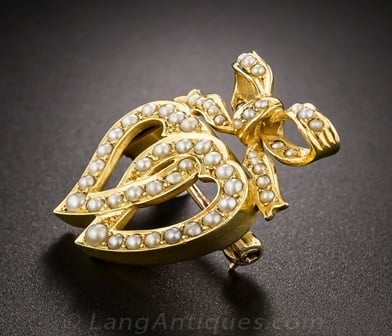A Guide to Late Victorian Aesthetic Period Jewelry
Late Victorian Aesthetic Period jewelry marked a turn from weighty opulence to more delicate designs. Learn more about this popular antique style.
2 Minute Read
What was the Aesthetic Period?
During this time period, electricity became a feature of newly constructed buildings. Thriving industries created a growing middle class with free time on its hands. As a result, the entertainment industry boomed. Actors and actresses became fashion trendsetters. Women formed an integral part of the workforce. They also enjoyed new found freedoms in leisure activities, such as tennis and bicycling.
The Aesthetic Period, and the Victorian Era, closed with the death of Queen Victoria in 1901.
Notable Characteristics of Aesthetic Period Jewelry
Jewelry pieces in the varied styles of this period fill antique stores across the country. Whether whimsical or imposing, this jewelry design period has a style for everyone.
Most Aesthetic Period jewelry was machine produced. Manufacturers stamped their marks on these pieces. However, many jewelers resented the onslaught of mass production and returned to hand fabrication.
The heavy jewelry of the Grand Period didn't fit well with women's new active lifestyles. Therefore, women's jewelry became lighter and smaller. Delicate rings, bracelets, and pins replaced the heavy opulence of previous years.
Late Victorian Period brooches had two-pronged lever clasps or hinged tube catches. Many featured attached safety pins.
Metal Work
Jewelry metals commonly used during this period included the following:
- Gold
- Rolled gold
- Silver
- Oxidized silver
- Platinum
Motifs
Etruscan and Egyptian revival themes continued to fascinate jewelry enthusiasts. Aesthetic Period pieces also featured Oriental and sporting themes.
Popular motifs included the following:
- Animal heads
- Barrels
- Bows
- Clovers
- Crescents
- Horseshoes
- Knots
- Oak leaves
- Owls
- Quatrefoils
- Stars
- Trefoils
- Wishbones
Designers often combined double hearts with crowns or knots.
Popular Gemstones and Cutting Styles
The jewelry of this period frequently featured the following gemstones:
- Amethyst
- Aquamarine
- Chrysoberyl
- Chrysoprase
- Diamond
- Emerald
- Black glass
- Horn
- Moonstone
- Opal
- Pearl
- Peridot
- Quartz
- Ruby
- Sapphire
- Turquoise
Notable gem cutting styles included the following:
- Rose Cut: round shape with a domed top and flat bottom.
- Old Mine Cut: rounded square shape with many facets. Closely resembles today's modern round brilliant cut.
- Old European Cut: round faceted shape. Although a precursor to today's modern round brilliant cut, it's clunkier. You'll frequently find this cut used in rings dated through the 1900s.
- Cabochon: rounded top and flat bottom.
What Were the Hot Items in Aesthetic Period Jewelry?
Tiffany and Co. kick-started the diamond solitaire engagement ring trend during this time period.
Popular pieces included small stud earrings, stick pins, and class rings. People often wore heart-shaped lockets on bracelets.
Small brooches were often worn en masse, scattered across necklines.
Vinaigrettes, small metal containers for scented sponges or spices, enjoyed widespread use.
Mizpah Jewelry
These pieces were emblazoned with the Hebrew word mizpah. This means "the Lord watch between me and thee while we are absent one from another." They became quite popular during the Aesthetic Period.
This ring, in excellent condition, features the word mizpah in 18k yellow and rose gold. The raised letters in alternating gold colors is unusual.
Chokers or Dog Collar-Style Necklaces
Collar-style necklaces like this were popular during the Aesthetic Period. Its seventeen inches of silver fit snugly around the throat. The links in this awesome find are hand engraved rather than machine stamped.
Megan Coward, Graduate Jeweler Gemologist, GIA, Graduate Gemologist
Megan Coward is a graduate of the GIA with Graduate Jeweler Gemologist and Graduate Gemologist accreditations. She has 20+ years in the retail jewelry industry in various roles including as a diamond buyer and gemstone appraiser.
Related Articles
The Orlov Diamond: A Tale of Power and Intrigue
Vintage Engagement Rings: Guide to Four Eras
The History of Lapidary
Early History of Jewelry: Ancient Times to the 17th Century
Latest Articles
800 Years of Mogok: A Celebration in Tenuous Times
What is the Average Gemstone Faceting Yield?
Pyroxmangite Value, Price, and Jewelry Information
How to Identify Emerald Simulants and Synthetics
Never Stop Learning
When you join the IGS community, you get trusted diamond & gemstone information when you need it.
Get Gemology Insights
Get started with the International Gem Society’s free guide to gemstone identification. Join our weekly newsletter & get a free copy of the Gem ID Checklist!
